The traditional RF signal source for 2-tone DR3 testing is to use a set of crystal oscillators or something like the venerable HP 8640b. The crystal based units offer the best phase noise and jitter performance - but they are fixed frequency arrangements which limits flexibility. The HP units provide the flexibility With acceptable phase noise/jitter numbers - but are moderate in price - and because of their age and complexity, generally require some amount of maintenance work. This project is an attempt to match up the modern DDS-type oscillator as a way to side-step some of these problems. The LO units are based around the Si570 kits offered by Kees K5BCQ. The SiLabs Si570 provides phase and jitter figures similar to the HP8640b and the cost of a single kit, inclusive of the LVDS version of the Si570 is under $60 USD. Jack Smith of Clifton Labs performed a series of tests on the kit. Including construction details and host helpfully, a comprehensive comparison with the HP 8640b in his lab. The wide-band test profile is shown here. The narrow band analysis is similar - the capabilities of the two units are quite similar. The march of technology is onward!!! For more details, see: http://www.cliftonlaboratories.com/si570_kit_from_k5bcq.htm Here is the layout of the front panel. Left side has the attenuation and filter selection controls. Right side is runs the Si570 related options. 

The Kees kits are not easy to panel mount so some improvisation was needed. The LCD and it's driver connect via a 10-pin header to the LO board inside the case. This allows the LCD and it's potential noise source to remain shielded from the sensitive inner workings. Extensions were placed on the control knobs and the Plexiglas plate serves to keep the Velcro-mounted LCD in place and protected. In the final work, the Plexiglas will be frosted with windows open for the LCD, and marking applied to provide comma-separators between the digits. The LCD is not back-lit unfortunately. Overall, the performance is outstanding and given the minimal price, a real value! 

The Si570 frequency range is around 3.5 MHz - 280 MHz. I wanted to have the capability of 450 kHz output which was accommodated by a cascade divider based on two high performance 74AS74 flip flops. That allows the minimum frequency range to extend down to about 230 kHz. The Si570 kit is very versatile - programming of the kit MCU was done by John Fisher K5JHF and he has really done an excellent job of anticipating the needs of many diverse uses. One feature allows the frequency display to be scaled vs. the actual output. Taking advantage of this, I have taped the divide-by-2 output of the flip-flops to provide a 1.7 MHz - 140 MHz frequency coverage of all the HF ham bands. And by using the kit scaling feature, the display shows this actual output frequency from the divider set. The signal from the dual Si570 LO unit is fed through a combiner, then through a series of attenuators and then into a LPF module. The attenuation and LPF selection are managed by a MCU. Extreme care was exercised in providing as much port to port isolation between the two Si570 module inputs. At 3.7 MHz, the unit provides about 54 db separation between the two ports between the combined action of the MC splitter acting as our combiner and the input termination pads. Here functionality was given a higher priority than assembly beauty, and it sure shows in this picture of the combiner: 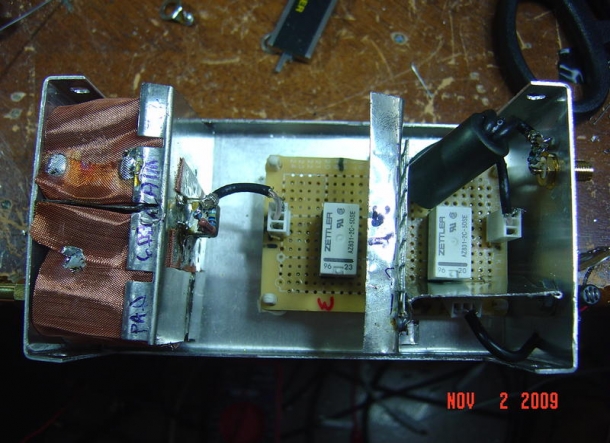 At the bottom are the LO units, on the right is a combiner and 2x 32 db relay-switched pads. And at the top is an 8-band LPF diode switched filter unit based on the 7-pole Coil Craft modules. Mounted to the right side of the LPF module is a 31.5 db Mini Circuits digital programmable attenuator. The generator's output level is set by the micro-controller driving the 3x 32 db fixed pads and the MC digital step attenuator. Offset tables in the MCU's programming adjust for leakage vs. frequency ensuring that the output level shown on the LCD is in fact the actual output for that frequency range. Bottom side of the LPF module. Built on a copper faced foil back-plane. 
Bottom shielding in place separates control logic from signal paths. 
Micro-controller module here - extra cable length and ZIF socket are removed in the final installation. 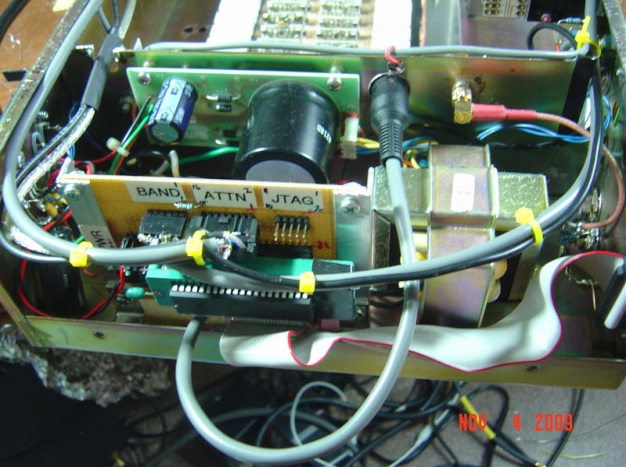 The Mikroe EasyAVR6 prototype board provides a basic platform for micro code development. Using this, the code can be tested in hardware without having to first build a host board for the micro. Here the system code is running and driving the LPF board switching circuitry. Mikroe makes boards for most common MCU including the PIC and Motorola series devices. Highly recommended for anyone wanting an easy to use prototyping platform. 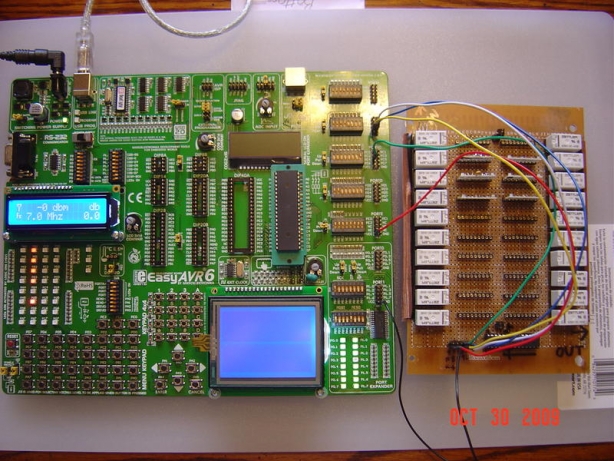 Independent lap results courtesy of Jack Smith, K8ZOA, Clifton Labs For the unit as-constructed, the signal topology is:  Using the single attenuator/LPF combination, the spectral purity results show 3rd order products at about -84dbc. 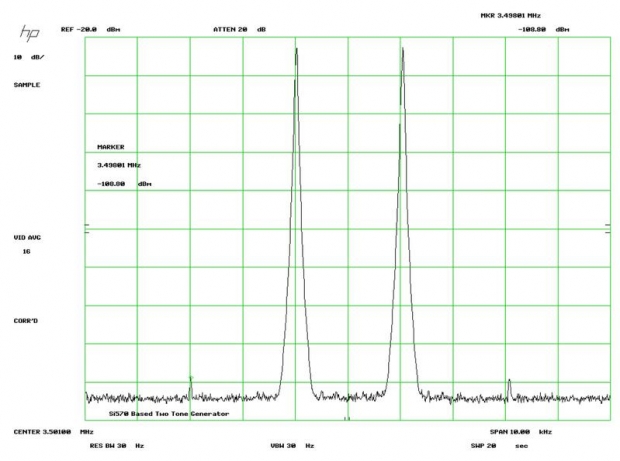
Performance can be further improved by providing LPF on the individual Si570 outputs. The revised topology is:  And looking at the 3rd order product specifically, we can see the improvement in this scan below. Purple line reflects the single LPF case, and the blue trace reflects the individual (dual) LPF case. In the latter, the IP3 level is just slightly above the noise floor. 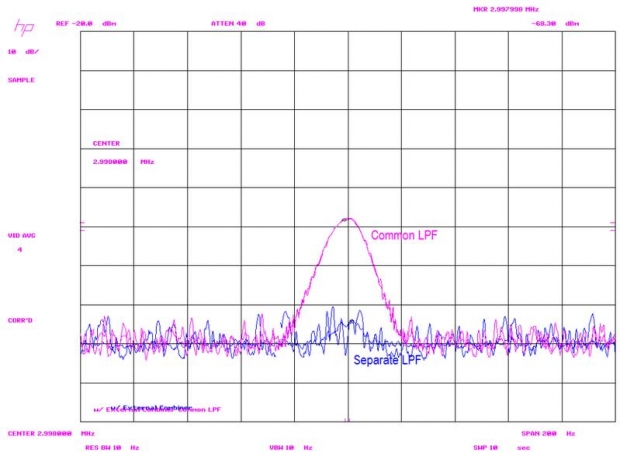
Conclusion: The generator is suitable for general purpose lab work. And thanks to Jack Smith and his excellent bench work, the following modifications will be implemented to take advantage of the test results: 1. The Si570 outputs and the internal combiner inputs will be terminated on the front panel. In the normal use case, a jumper will feed the internal combiner from the Si570. 2. In the high-specification DR3 testing (as we anticipate will be needed with the FT2000 1st IF revisions), the Si570 outputs will be fed individually into external LPF and attenuators. And then combined into an external Mini Circuits splitter. 3. The output level calibration is off roughly 6db at about -22 dbm. The output level of the Si570 will be revised to approximately 0 dbm which should allow a -13 dbm (S9+60) level suitable for S-meter calibration work without the use of an external amplifier. UPDATE The modification to bring out the signals to the front panel is complete. I still need to provide the return path connections internally but was in a hurry with the FT-2000 roofing filter project taking center stage. The external dual LPF module looks like this: 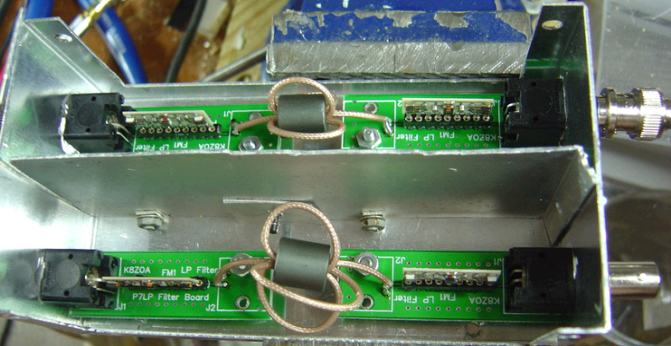
Transmission plots showing rejection when loaded with dual 15 MHz LPF elliptical pairs. 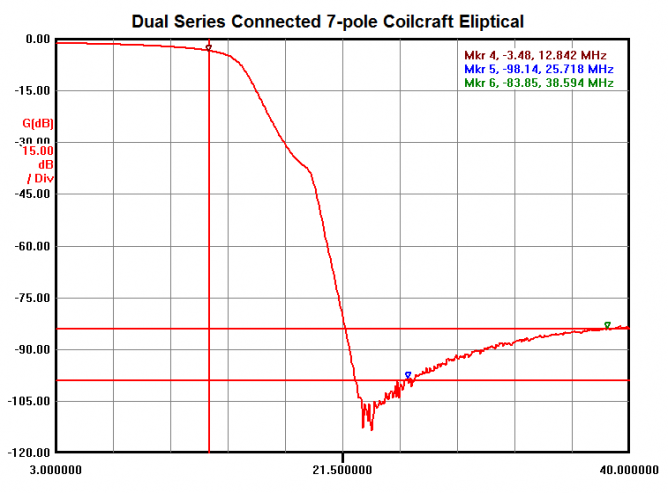
Filter isolation plots (crosstalk between filter paths). 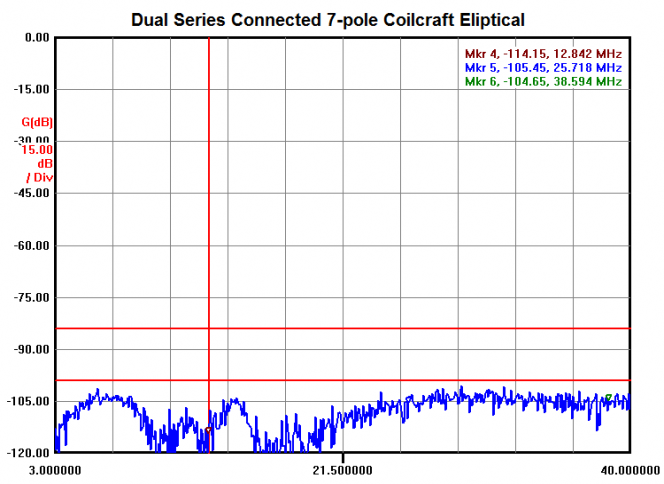
LINKS Professional Lab work on a contract basis: http://www.cliftonlaboratories.com/ K5BCQ Si570 kit: http://www.qsl.net/k5bcq/Kits/Kits.html Coilcraft LPF: http://www.coilcraft.com/lcfilt.cfm Si570 Datasheet: http://www.coilcraft.com/lcfilt.cfm Mikroe EasyAVR6: http://www.mikroe.com/en/tools/easyavr6/ |